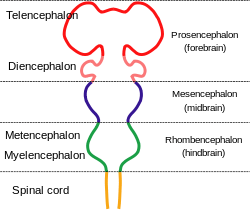Prosencephalon
| Brain: Prosencephalon (Forebrain) | |
|---|---|
 Diagram depicting the main subdivisions of the embryonic vertebrate brain. These regions will later differentiate into forebrain, midbrain and hindbrain structures. | |
| Gray's | p.741 |
| NeuroLex ID | birnlex_1509 |
In the anatomy of the brain of vertebrates, the prosencephalon (or forebrain) is the rostral-most (forward-most) portion of the brain. The prosencephalon, the mesencephalon (midbrain), and rhombencephalon (hindbrain) are the three primary portions of the brain during early development of the central nervous system. It controls body temperature, reproductive functions, eating, sleeping, and any display of emotions.
At the five-vesicle stage, the prosencephalon separates into the diencephalon (prethalamus, thalamus, hypothalamus, subthalamus, epithalamus, and pretectum) and the telencephalon (cerebrum). The cerebrum consists of the cerebral cortex, underlying white matter, and the basal ganglia.
By 5 weeks in utero, it is visible as a single portion toward the front of the fetus. At 8 weeks in utero, the prosencephalon splits into the left and right cerebral hemispheres.
When the embryonic prosencephalon fails to divide the brain into two lobes, it results in a condition known as holoprosencephaly.
Additional images
-

Embryo between eighteen and twenty-one days.
-

Head of chick embryo of about thirty-eight hours’ incubation, viewed from the ventral surface. X 26
See also
External links
| ||||||||||||||||||||||||
| ||||||||||||||||||||||||||||||||||||||||||||||||||||||